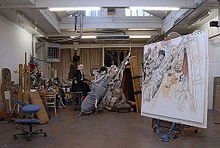Paula Rego
Portuguese-British visual artist (1935-2022)
Dame Maria Paula Figueiroa Rego (January 16 1935 - June 8 2022) was a Portuguese-British artist known for her work relating to storybooks, feminism, and the country of Portugal.

Quotes
edit- 'These women are not victims' – Paula Rego's extraordinary Abortion series (Thursday 9 June 2022 07.00 BST)
- English Quotations
- When a painting works, it brings enormous relief, as it can be a struggle to get there.
- I try and get justice for women… at least in the pictures… Revenge too.
- Every picture takes courage. All artists are brave.
- I've always taken great pleasure from things that aren't supposed to be art. There's a snobbishness that acts as a censor. I've always liked cartoons for instance, and Disney films and many illustrators.
- I wanted to be in the big boys' club, with the great painters I admired.
- As quoted in a BBC Article
- It was a fascist state for everyone, but it was especially hard for women. They got a raw deal.
- My paintings are stories, but they are not narratives, in that they have no past and future.
- As quoted in New York Times obituary (15 June 2022).
- “What you can do in pictures, that never stops.”
- As quoted in a "Paula Rego’s influence will live on—here's why her market will too" The Art Newspaper (28 July 2022)
Quotes about Rego
editQuotes in alphabetical order by author or source.
- Paula lived for her work.
- She belong[ed] to a category of artists who are fully and consistently producing work, incredibly rare for a female artist [of her generation].
- I see [her influence] in the work of most female painters – particularly in artists who engage with the body – and with women's position in the world, In fact, I would struggle to think of a significant painter, particularly in Britain, where I can't see a connection to Paula.
- Paula takes you to uncomfortable places – Jung called it the Shadow. They are taboo areas, where love and cruelty touch each other
- Elena Crippa, an art curator, who worked with Rego. In the BBC Culture (13 July 2021) article.
- Paula Rego is a great artist, and an underrated artist... whether she's tackling war, or 'honour' killing, nothing escapes her awareness of the challenges of life… she's shocking sometimes, and exciting – but that's one of the roles of art.
- Art historian and curator Catherine Lampert in a "Paula Rego: The artist who helped change the world" BBC Culture (13 July 2021)
- Each and every one is subtly disturbing without it being clear quite why.
- Michael Prodger in "The mysterious and unsettling pictures of Paula Rego" in The New Statesman (14 July 2021), quoted in The New York Times (15 June 2022).
- The vigour of her hand and brilliance of her technique meant she could realise singular, wondrous and disturbing scenes rising in her mind’s eye with unflinching honesty; these images are ambivalent, often perverse, mischievous, with undercurrents of danger. She generated hundreds of entirely original scenarios that are often baffling yet go straight through to the nervous system of the viewer, as Francis Bacon (whom she admired), wished to do. She called her style "beautiful grotesque", a phrase that catches the contradictions in her images, but does not convey the strength and strangeness of the bodies she painted, the turbulent force of her compositions and the sympathy she shows in her depiction of emotions and ordeals.
- Her studio, in Kentish Town, north London, was a prop room, a wardrobe, a rehearsal stage, a theatre—her playroom. ... Rego also drew on family and friends to enact her scenarios: her daughters, her grand-daughters, and her partner, the writer and publisher Anthony Rudolf. Rudolf has said that he realised early on that if he wanted to have time with Paula, the only way was to sit for her. He appears in many roles, sometimes cross-dressed, at other times naked as Gregor Samsa in the painting Metamorphosis, or the dead Christ in the mysteries of the life of the Virgin, which Rego painted for the president of Portugal in 2002. When no model fitted her vision, she made “dollies”, stuffed, bulbous puppets that she did not disguise, and who like the sinister Pillowman, haunt her most troubling scenes.
- Marina Warner "Remembering Paula Rego: an artist who could realise wondrous and disturbing scenes with unflinching honesty" The Art Newspaper (24 June 2022)